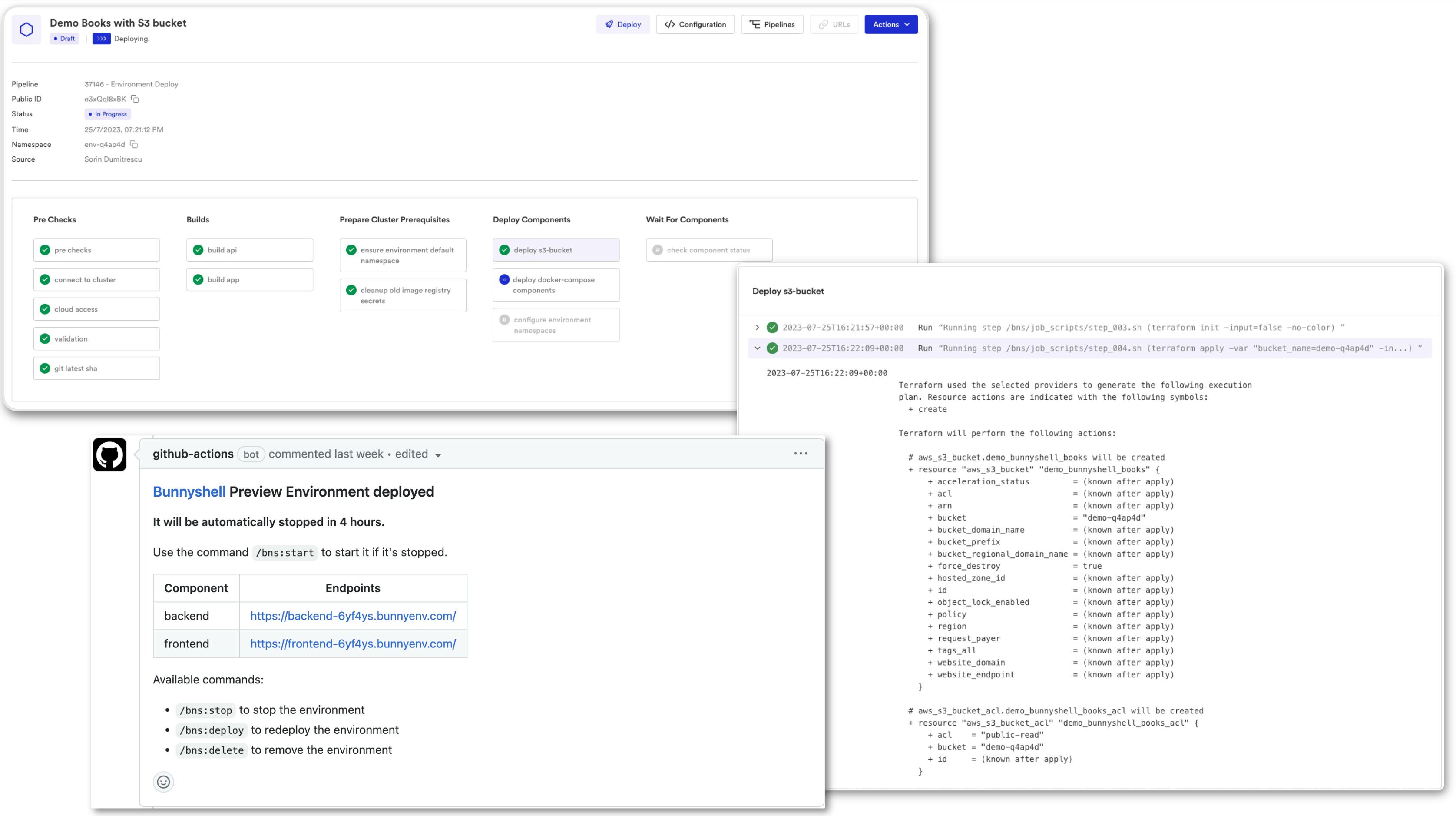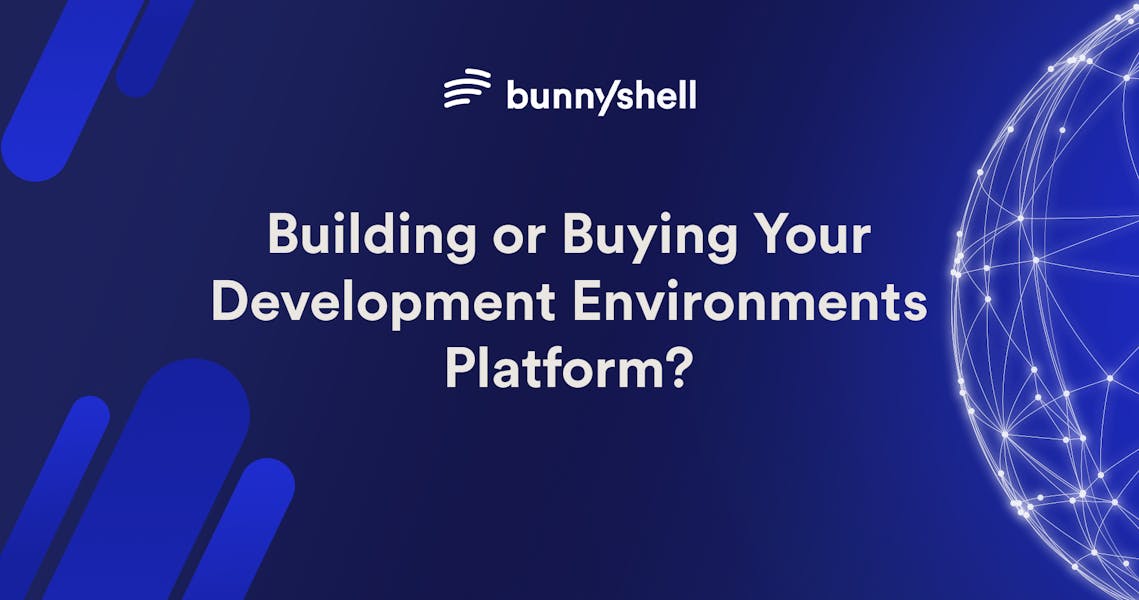At one point, almost all organizations will face problems with their development environments. There are two options to address this: either consider building an internal development platform to help the team code in the cloud directly or buy an off-the-shelf tool that can be used with minimal integrations.
Both options have their pros and cons, and in this article, we’ll explore both to help you make an informed decision.
The Case for Building Your Internal Developer Platform
A custom-made solution that enables you full control over the specifications, a deep understanding of the platform and technologies used, and better security - these are usually the main reasons organizations use to argue about building their own development environments.
But is that really so?
Let’s take each argument one by one.
A custom-made solution that enables you full control over the specifications. In theory, this sounds great, usually because you’re not paying for features you don’t need or use. But as Uncle Ben said, with great (customization) power comes great responsibility.
When you’re building your own solution, you’re also in charge of upkeeping it, fixing bugs, adding new functionalities, ensuring its security, offering support, etc. Is this something you’re really able to do? Meaning do you have the resources (time, money, knowledge) to do so?
A deep understanding of the platform and technologies used. Sure, when you’re building something from scratch yourself, you know best what’s under the hood. But deep familiarity with a platform can also come from usage, using that platform day in and day out.
In contrast, if key people who worked on developing your in-house solution leave your company, whom are you going to turn to? How are you going to not only upkeep it but improve it?
And last but not least, security. Having a solution that only you have access to can give off a fake sense of security. Who is actually in charge of security in your organization? Your developers? Do you have a SecOps team? Do you want to build one? (meaning, is it profitable for you to build one?) Do you have recurrent security audits? Having someone else worrying about security for you is usually a good thing.
This brings us to…
The Case for Buying a Self-Serviced Development Environments Platform
There are plenty of reasons why buying an off-the-shelf solution is better than building your own (and I’ll list them all below). However, the ugly truth is that it all comes down to money: how much you need to invest, what you’re getting in return, and, most importantly, and something not all organizations take into consideration, the money you lose while you’re building your own solution.
Buying a development platform can help you eliminate lost opportunities cost and the total cost of ownership (TCO). Let’s see how.
Buying a development environment is more resource-efficient
I will start with a cold shower: it took us 3 years and several investment rounds to bring Bunnyshell to its current version, and that’s all we’ve done in this time. Do you think you can build your own internal development platform (even if it’s a more rudimentary version) while also servicing your clients and growing your business? For most organizations, that’s a very unrealistic expectation.
What I’m trying to say is that building your own tool blocks your resources for an extended period of time, time that you might not always have. While you’re busy building, you might not have the time and manpower to service your customers properly or at all. And what if you’re looking to acquire new customers with different requirements, but you need to build additional functionalities first? Prospects could be long gone before you finish implementing the changes, and then you’re left with something no one will ever use (because it was custom-built for them, and because technology moves so fast six months from now something could become obsolete). Who is going to cover that cost and how?
Here’s another caveat: building your own solution keeps your developers from bringing value to your business. Because instead of investing their effort into your own product, you’re actually removing them from your core business activities. Instead of them using their time to learn new technologies that can improve your product, they are wasting their time upkeeping a tool that is never finished and that brings limited value (if any) to your business.
But perhaps the biggest cost you pay when building your own development solution is that you don’t have the flexibility to pivot. We ourselves have pivoted our product a few times from the initial release to the version you see today, so we know how important flexibility and scalability are to an organization. But when you have your own in-house tools, dramatic shifts and changes are either impossible to make or very costly and time-consuming. So once again, you’re blocking your resources into your tool, and by the time you’re finished, the opportunity to disrupt your industry could be long gone. Or you’ll deprioritize the spin-off and stop your industry disruption process.
When you’re buying a development environment, there’s no ownership cost
When thinking about building an internal tool, organizations usually only consider two things: the time and money this will take. What they oftentimes fail to take into account, however, is the ongoing maintenance cost that comes after, which can spike to hundreds of thousands of dollars very fast and very easily.
Here’s what it really costs you to build your own development environment:
- Infrastructure-related costs: to build an internal tool, first, you need a technical infrastructure you can build upon. This requires ongoing maintenance and upgrades, and as your business scales, your infrastructure-related costs will also scale exponentially.
- Cost of integration: your development platform can’t just function on its own - it needs to be integrated with all your other systems and be compatible with various tools, frameworks, and programming languages. This ongoing maintenance and upgrades can put a big hole in your budget very fast.
- Cost of adding new features: what makes building your own solution attractive to many organizations is the idea that they can customize it however they like. And indeed, that’s a big plus. However, you need to stop and think: how often will you use that custom feature you’re building? How profitable is it to build, maintain, and upgrade a feature you’re only going to use once? And, most importantly, will there still be someone using it two years from now?
- Security costs: when you’re building something, you’re also in charge of securing it. Access controls, data encryption, security testing - these are all things you will be paying for. And this doesn’t even include the costs associated with a security breach.
Are all these costs something you want to spend your money on? Or do you want to invest that money into your product instead?
The Advantages and Disadvantages of Building vs. Buying Your Development Environments Platform
To make the comparison easier for you, here’s a graphic representation of the pros and cons:
| Advantages | |
| Build | Buy |
| Complete freedom over the specifications | Lower costs, you pay for what you use |
| Full control, no reliance on third-parties | Better time to market |
| Deep knowledge of the solution | No overhead costs |
| Ability to add customer features | Vendor support |
| Disadvantages | |
| Build | Buy |
| Long development process with potential pivots | Dependence on a third-party |
| Unforeseen costs associated with maintenance and scaling | Difficult (but not impossible) and slower process to add new custom features |
| Need to comply with local regulations regarding user data | |
| Increased responsibility over user data |
How to Decide Between Building vs. Buying a Development Environments Platform
When deciding to choose one option over the other, take into account your available resources (not only budget but also manpower and knowledge), the impact your choice will have on your business long-term, and whether the solution is scalable as your organization grows and, therefore, your needs increase as well.
The last thing you want to do is burn money building a solution only to realize midway that’s no longer serving you and then spend even more money migrating to a third-party provider when you could have done so from the beginning.
Here are some questions you should ask yourself when making a decision:
- What’s my budget?
- What do I want to focus on?
- Are my developers able to build a development platform? Do they have the skills?
- Do I have the time to build a tool in-house?
- Can I handle security and compliance?
- Will I be able to build something that is decidedly better than everything available on the market today?
If your answers are not favorable to most of these questions, perhaps it’s better to consider buying a self-serviced development environment.
Bunnyshell, an Environments as a Service Platform
Bunnyshell provides a streamlined, out-of-the-box build and deploy pipeline, designed to simplify your deployment process. However, we understand that every team has its unique workflow, which is why Bunnyshell also allows for integration with your existing Continuous Integration (CI) processes. This flexibility ensures that you can leverage the power of Bunnyshell without disrupting your established workflows.
In addition to this, our team has crafted specific workflows to integrate seamlessly with GitHub Actions. These workflows enable the creation of full-stack environments during pull requests, further enhancing your development and deployment process. With Bunnyshell, you get a platform that not only simplifies deployment but also adapts to your needs, making your software development cycle more efficient and effective.

Bunnyshell offers a wide array of integration options for managed Kubernetes clusters across various cloud providers. This native integration capability allows for seamless connection to your clusters. However, the flexibility doesn’t stop there. With Bunnyshell, you can connect any cluster, irrespective of its location, using the Kubernetes API. This ensures that you have complete control over your clusters, no matter where they are hosted.
In addition to Kubernetes, Bunnyshell also supports the integration of other cloud-managed services through the use of Terraform modules. This means you can easily incorporate and manage a variety of services from different cloud providers, all from within the Bunnyshell platform.
The ability to integrate with multiple cloud providers and services positions Bunnyshell as a platform that truly supports a multi-cloud approach. This means you can distribute your application environments across different cloud platforms, taking advantage of the unique benefits each one offers, all while managing them from a single, unified platform.
With Bunnyshell, multi-cloud application environment management is not just possible, it’s simple and efficient.

